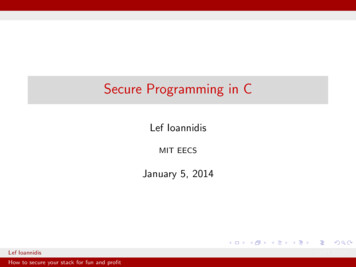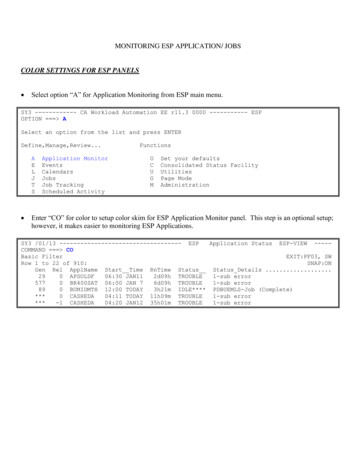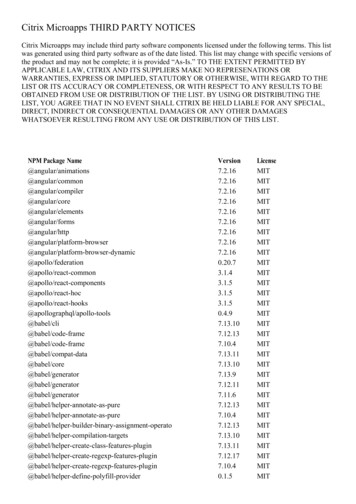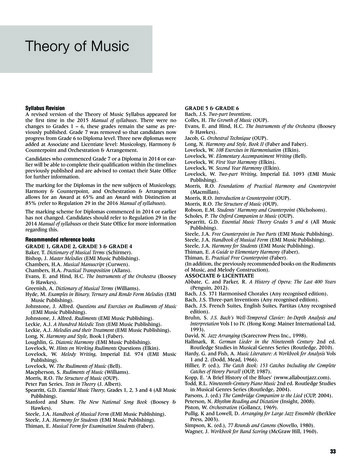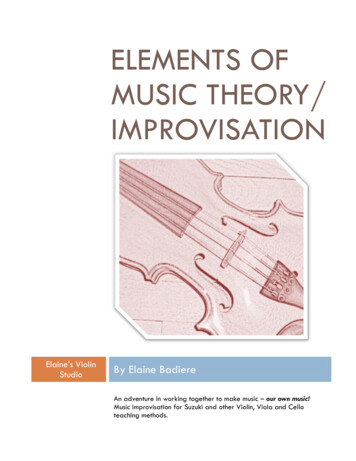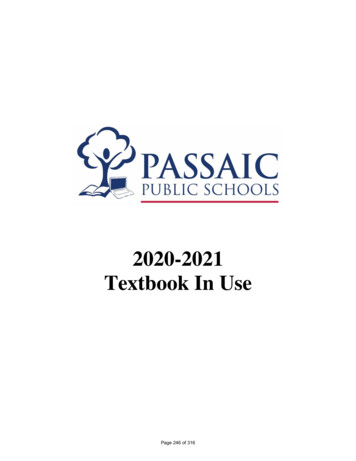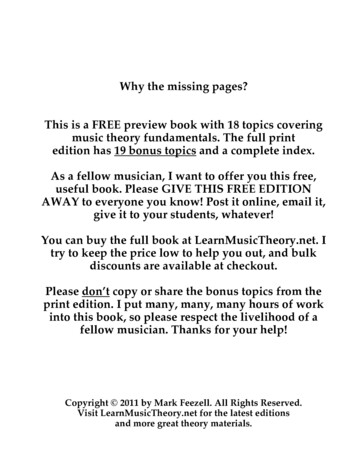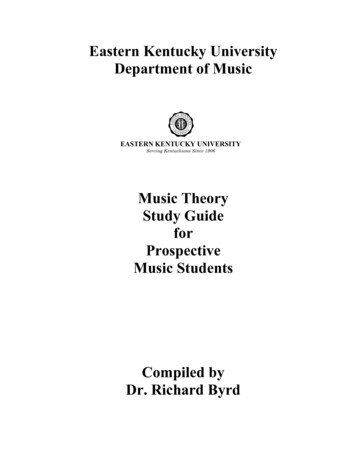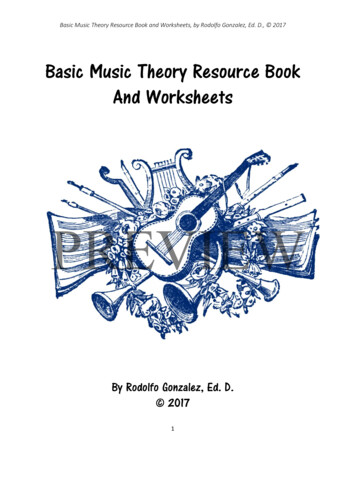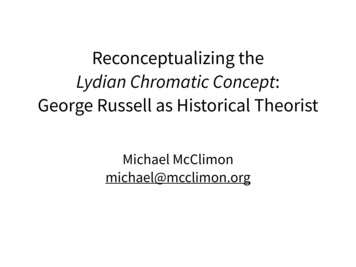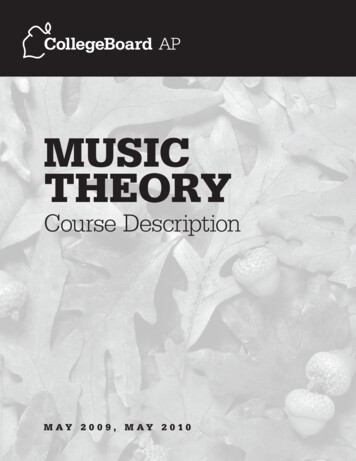
Transcription
MusicTheoryCourse DescriptionM ay 2 0 0 9, M ay 2 010
The College Board: Connecting Students to College SuccessThe College Board is a not-for-profit membership association whose mission is to connect studentsto college success and opportunity. Founded in 1900, the association is composed of more than5,400 schools, colleges, universities, and other educational organizations. Each year, the CollegeBoard serves seven million students and their parents, 23,000 high schools, and 3,500 collegesthrough major programs and services in college admissions, guidance, assessment, financialaid, enrollment, and teaching and learning. Among its best-known programs are the SAT , thePSAT/NMSQT , and the Advanced Placement Program (AP ). The College Board is committedto the principles of excellence and equity, and that commitment is embodied in all of its programs,services, activities, and concerns.For further information visit www.collegeboard.com.The College Board and the Advanced Placement Program encourage teachers, AP Coordinators,and school administrators to make equitable access a guiding principle for their AP programs.The College Board is committed to the principle that all students deserve an opportunity toparticipate in rigorous and academically challenging courses and programs. All students whoare willing to accept the challenge of a rigorous academic curriculum should be considered foradmission to AP courses. The Board encourages the elimination of barriers that restrict access toAP courses for students from ethnic, racial, and socioeconomic groups that have been traditionallyunderrepresented in the AP Program. Schools should make every effort to ensure that their APclasses reflect the diversity of their student population. 2008 The College Board. All rights reserved. College Board, Advanced Placement Program, AP, AP Central, SAT, and theacorn logo are registered trademarks of the College Board. connect to college success is a trademark owned by the CollegeBoard. PSAT/NMSQT is a registered trademark of the College Board and National Merit Scholarship Corporation. All otherproducts and services may be trademarks of their respective owners. Permission to use copyrighted College Board materialsmay be requested online at: www.collegeboard.com/inquiry/cbpermit.html.Visit the College Board on the Web: www.collegeboard.com.
Dear Colleague:We know that AP is a unique collaboration among motivated students, dedicatedteachers, and committed high schools, colleges, and universities. Without yourcontributions, the rigorous instruction that takes place in classrooms around theworld would not be possible.In 2007, approximately 1.4 million students took more than 2.5 million AP Exams.Guiding these students were talented, hardworking teachers, who are the heart andsoul of the AP Program. The College Board is grateful for the dedication of APteachers and the administrators who support them.One example of the collaboration that makes AP possible is the AP Course Audit,the process through which college faculty review AP teachers’ syllabi to ensure thatboth teachers and administrators are aware of the expectations colleges anduniversities have for AP courses. This yearlong intensive assessment involved thereview and analysis of more than 134,000 syllabi to determine which courses fulfillor exceed standards for college-level curricula. In total, 14,383 secondary schoolsworldwide succeeded in developing one or more courses that have receivedauthorization from the College Board.Through the AP Audit, teachers received a number of benefits. For example,you or your colleagues told us that the AP Audit helped you to obtain more currentcollege textbooks for your students. A significant number of teachers said theywere able to prevent the reduction of lab or instructional time that was scheduledto affect their courses. Because of the audit, 22,000 teachers said they were ableto incorporate advances in their discipline that had not yet been added to theircurricula. The searchable AP Course Ledger is online at collegeboard.com.The College Board remains committed to supporting the work of AP teachers.AP workshops and Summer Institutes held around the world provide stimulatingprofessional development for more than 60,000 teachers each year. Workshopsprovide teachers not only with valuable course-specific information but theopportunity to interact and network with their colleagues in the AP community.This community is extended online at AP Central where teachers can access awide range of resources, information, and tools to support their work in the APclassroom. In response to requests from educators to make our Web site easier touse, the College Board implemented extensive improvements to collegeboard.com.A new “K–12 Teacher” homepage makes it easier to find an array of content andservices. AP Central serves as an integral part of this enhanced collegeboard.comWeb site.We appreciate all of your efforts in the AP classroom and in the courses thatprepare students for the rigor and challenge of AP. It is through the dedication andhard work of educators like you that a wider range of students than ever before isbeing given the opportunity to succeed in AP.Sincerely,Gaston CapertonPresidentThe College Boardi
ii
ContentsWelcome to the AP Program . . . . . . . . . . . . . . . . . . . . . . . . . . . . . . . . . . . . . . . . . . . . . . . . .AP Courses. . . . . . . . . . . . . . . . . . . . . . . . . . . . . . . . . . . . . . . . . . . . . . . . . . . . . . . . . . . . .AP Exams . . . . . . . . . . . . . . . . . . . . . . . . . . . . . . . . . . . . . . . . . . . . . . . . . . . . . . . . . . . . . .AP Course Audit. . . . . . . . . . . . . . . . . . . . . . . . . . . . . . . . . . . . . . . . . . . . . . . . . . . . . . . . .AP Courses and Exams. . . . . . . . . . . . . . . . . . . . . . . . . . . . . . . . . . . . . . . . . . . . . . . . . . .AP Reading. . . . . . . . . . . . . . . . . . . . . . . . . . . . . . . . . . . . . . . . . . . . . . . . . . . . . . . . . . . . .AP Exam Grades . . . . . . . . . . . . . . . . . . . . . . . . . . . . . . . . . . . . . . . . . . . . . . . . . . . . . . . .Credit and Placement for AP Grades . . . . . . . . . . . . . . . . . . . . . . . . . . . . . . . . . . . . .Setting Credit and Placement Policies for AP Grades . . . . . . . . . . . . . . . . . . . . . . .111123334AP Music Theory . . . . . . . . . . . . . . . . . . . . . . . . . . . . . . . . . . . . . . . . . . . . . . . . . . . . . . . . . . . 5Introduction . . . . . . . . . . . . . . . . . . . . . . . . . . . . . . . . . . . . . . . . . . . . . . . . . . . . . . . . . . . . 5Subscore Grades . . . . . . . . . . . . . . . . . . . . . . . . . . . . . . . . . . . . . . . . . . . . . . . . . . . . . 6The Course . . . . . . . . . . . . . . . . . . . . . . . . . . . . . . . . . . . . . . . . . . . . . . . . . . . . . . . . . . . . 6Goals . . . . . . . . . . . . . . . . . . . . . . . . . . . . . . . . . . . . . . . . . . . . . . . . . . . . . . . . . . . . . . . 7Content . . . . . . . . . . . . . . . . . . . . . . . . . . . . . . . . . . . . . . . . . . . . . . . . . . . . . . . . . . . . . 7The Exam . . . . . . . . . . . . . . . . . . . . . . . . . . . . . . . . . . . . . . . . . . . . . . . . . . . . . . . . . . . . . . 9Terms and Symbols Used on the AP Music Theory Exam. . . . . . . . . . . . . . . . . . 11Exam Format. . . . . . . . . . . . . . . . . . . . . . . . . . . . . . . . . . . . . . . . . . . . . . . . . . . . . . . . 18Multiple-Choice Section . . . . . . . . . . . . . . . . . . . . . . . . . . . . . . . . . . . . . . . . . . . . . . . 18Sample Multiple-Choice Questions . . . . . . . . . . . . . . . . . . . . . . . . . . . . . . . . . . . 19Questions Based on Aural Stimulus . . . . . . . . . . . . . . . . . . . . . . . . . . . . . . . . 19Questions Not Based on Aural Stimulus . . . . . . . . . . . . . . . . . . . . . . . . . . . . 28Answers to Multiple-Choice Questions . . . . . . . . . . . . . . . . . . . . . . . . . . . . . 35Written Free-Response Section . . . . . . . . . . . . . . . . . . . . . . . . . . . . . . . . . . . . . . . . . 36Sample Free-Response Questions . . . . . . . . . . . . . . . . . . . . . . . . . . . . . . . . . . . . 36Sight-Singing Portion . . . . . . . . . . . . . . . . . . . . . . . . . . . . . . . . . . . . . . . . . . . . . . . . . 44Sample Sight-Singing Questions . . . . . . . . . . . . . . . . . . . . . . . . . . . . . . . . . . . . . 44Teacher Support. . . . . . . . . . . . . . . . . . . . . . . . . . . . . . . . . . . . . . . . . . . . . . . . . . . . . . . . . . .AP Central (apcentral.collegeboard.com). . . . . . . . . . . . . . . . . . . . . . . . . . . . . . . . . . .AP Publications and Other Resources. . . . . . . . . . . . . . . . . . . . . . . . . . . . . . . . . . . . . .Teacher’s Guides. . . . . . . . . . . . . . . . . . . . . . . . . . . . . . . . . . . . . . . . . . . . . . . . . . . . .Course Descriptions. . . . . . . . . . . . . . . . . . . . . . . . . . . . . . . . . . . . . . . . . . . . . . . . . .Released Exams . . . . . . . . . . . . . . . . . . . . . . . . . . . . . . . . . . . . . . . . . . . . . . . . . . . .474747474747 2008 The College Board. All rights reserved. Visit the College Board on the Web: www.collegeboard.com.iii
Welcome to the AP ProgramThe Advanced Placement Program (AP) is a collaborative effort among motivatedstudents; dedicated teachers; and committed high schools, colleges, and universities.Since its inception in 1955, the Program has enabled millions of students to takecollege-level courses and exams, and to earn college credit or placement, while stillin high school.Most colleges and universities in the United States, as well as colleges anduniversities in more than 40 other countries, have an AP policy granting incomingstudents credit, placement, or both on the basis of their AP Exam grades. Many ofthese institutions grant up to a full year of college credit (sophomore standing) tostudents who earn a sufficient number of qualifying AP grades.Each year, an increasing number of parents, students, teachers, high schools, andcolleges and universities turn to the AP Program as a model of educational excellence.More information about the AP Program is available at the back of this CourseDescription and at AP Central, the College Board’s online home for AP professionals(apcentral.collegeboard.com). Students can find more information at the AP studentsite (www.collegeboard.com/apstudents).AP CoursesThirty-seven AP courses in a wide variety of subject areas are available now. Acommittee of college faculty and master AP teachers designs each AP course tocover the information, skills, and assignments found in the corresponding collegecourse. See page 2 for a complete list of AP courses and exams.AP ExamsEach AP course has a corresponding exam that participating schools worldwideadminister in May (except for AP Studio Art, which is a portfolio assessment).AP Exams contain multiple-choice questions and a free-response section (essay,problem solving, or oral response).AP Exams are a culminating assessment in all AP courses and are thus an integralpart of the Program. As a result, many schools foster the expectation that studentswho enroll in an AP course will take the corresponding AP Exam. Because theCollege Board is committed to providing access to AP Exams for homeschooledstudents and students whose schools do not offer AP courses, it does not requirestudents to take an AP course prior to taking an AP Exam.AP Course AuditThe AP Course Audit was created at the request of secondary school and college anduniversity members of the College Board who sought a means to provide teachersand administrators with clear guidelines on the curricular and resource requirementsthat must be in place for AP courses. The AP Course Audit also helps colleges anduniversities better interpret secondary school courses marked “AP” on students’transcripts. To receive authorization from the College Board to label a course “AP,” 2008 The College Board. All rights reserved. Visit the College Board on the Web: www.collegeboard.com.1
schools must demonstrate how their courses meet or exceed these requirements,which colleges and universities expect to see within a college-level curriculum.The AP Program unequivocally supports the principle that each individual schoolmust develop its own curriculum for courses labeled “AP.” Rather than mandatingany one curriculum for AP courses, the AP Course Audit instead provides eachAP teacher with a set of expectations that college and secondary school facultynationwide have established for college-level courses. AP teachers are encouragedto develop or maintain their own curriculum that either includes or exceeds each ofthese expectations; such courses will be authorized to use the “AP” designation.Credit for the success of AP courses belongs to the individual schools and teachersthat create powerful, locally designed AP curricula.Complete information about the AP Course Audit is available at AP Central.AP Courses and ExamsArtArt HistoryStudio Art: 2-D DesignStudio Art: 3-D DesignStudio Art: DrawingBiologyCalculusCalculus ABCalculus BCChemistryChinese Language and CultureComputer ScienceComputer Science AComputer Science lish Language and CompositionEnglish Literature and CompositionEnvironmental ScienceFrenchFrench LanguageFrench Literature*German LanguageGovernment and PoliticsComparative Government and PoliticsUnited States Government and PoliticsHistoryEuropean HistoryUnited States HistoryWorld HistoryHuman GeographyItalian Language and Culture*Japanese Language and CultureLatinLatin Literature*Latin: VergilMusic TheoryPhysicsPhysics BPhysics C: Electricity and MagnetismPhysics C: MechanicsPsychologySpanishSpanish LanguageSpanish LiteratureStatistics*AP Computer Science AB, AP French Literature, and AP Latin Literature will be discontinued after the May 2009exam administration. AP Italian may also be discontinued if external funding is not secured by May 2009. VisitAP Central for details.2 2008 The College Board. All rights reserved. Visit the College Board on the Web: www.collegeboard.com.
AP ReadingAP Exams—with the exception of AP Studio Art, which is a portfolio assessment—consist of dozens of multiple-choice questions scored by machine, and free-responsequestions scored at the annual AP Reading by thousands of college faculty andexpert AP teachers. AP Readers use scoring standards developed by college anduniversity faculty who teach the corresponding college course. The AP Readingoffers educators both significant professional development and the opportunity tonetwork with colleagues. For more information about the AP Reading, or to applyto serve as a Reader, visit apcentral.collegeboard.com/readers.AP Exam GradesThe Readers’ scores on the free-response questions are combined with the results ofthe computer-scored multiple-choice questions; the weighted raw scores are summedto give a composite score. The composite score is then converted to a grade onAP’s 5-point scale:AP GRADE54321QUALIFICATIONExtremely well qualifiedWell qualifiedQualifiedPossibly qualifiedNo recommendationAP Exam grades of 5 are equivalent to A grades in the corresponding collegecourse. AP Exam grades of 4 are equivalent to grades of A , B , and B in college.AP Exam grades of 3 are equivalent to grades of B , C , and C in college.Credit and Placement for AP GradesThousands of four-year colleges grant credit, placement, or both for qualifying APExam grades, because these grades represent a level of achievement equivalent tothat of students who take the corresponding college course. That college-levelequivalency is ensured through several AP Program processes:1. The involvement of college faculty in course and exam development and otherAP activities. Currently, college faculty: Serve as chairs and members of the committees that develop the CourseDescriptions and exams in each AP course. Are responsible for standard setting and are involved in the evaluation of studentresponses at the AP Reading. The Chief Reader for each AP subject is a collegefaculty member. Teach professional development institutes for experienced and new AP teachers. Serve as the senior reviewers in the annual AP Course Audit, ensuring APteachers’ syllabi meet the curriculum guidelines of college-level courses. 2008 The College Board. All rights reserved. Visit the College Board on the Web: www.collegeboard.com.3
2. AP courses and exams are reviewed and updated regularly based on the resultsof curriculum surveys at up to 200 colleges and universities, collaborationsamong the College Board and key educational and disciplinary organizations,and the interactions of committee members with professional organizations intheir discipline.3. Periodic college comparability studies are undertaken in which the performance ofcollege students on AP Exams is compared with that of AP students to confirm thatthe AP grade scale of 1 to 5 is properly aligned with current college standards.For more information about the role of colleges and universities in the APProgram, visit the Higher Ed Services section of collegeboard.com at professionals.collegeboard.com/higher-ed.Setting Credit and Placement Policies for AP GradesThe College Board Web site for education professionals has a section geared towardcolleges and universities that provides guidance in setting AP credit and placementpolicies and additional resources, including links to AP research studies, releasedexam questions, and sample student responses at varying levels of achievement foreach AP Exam. Visit /ap.The AP Credit Policy Info online search tool provides links to credit and placement policies at more than 1,000 colleges and universities. The tool helps studentsfind the credit hours and advanced placement they can receive for qualifyingexam scores within each AP subject. AP Credit Policy Info is available atwww.collegeboard.com/ap/creditpolicy.4 2008 The College Board. All rights reserved. Visit the College Board on the Web: www.collegeboard.com.
AP Music TheoryI n tr o d u cti o nThe AP Music Theory Development Committee has sought the advice of bothhigh school and college faculties to define the scope of work that would be equivalent tofirst-year college courses in music theory. Because the theory curriculum variesconsiderably from college to college, the Development Committee has chosen toprovide general course guidelines rather than a precise course description. TheAP Music Theory Teacher’s Guide contains several sample syllabi of actual AP andcollege theory courses. Additional resources for teachers include workshops offered bythe College Board Regional Offices and advice from members of the DevelopmentCommittee. Committee members, listed on the back cover, welcome hearing fromAP teachers who wish to consult with them.* The guidelines contained in this CourseDescription reflect a range of skills typically developed during introductory collegecourses in music theory. Each AP teacher is encouraged to keep these guidelines inmind while planning a course that best fits his or her specific situation and training. Thefoundation of knowledge presented in the year-long AP Music Theory course duringhigh school provides students with the opportunity to develop, practice, and mastermusic theory skills essential to success in post-secondary music theory course work.The AP Music Theory Exam is intended for secondary school students who havecompleted music theory studies comparable to introductory college courses in musictheory. Because college curricula vary for beginning Music Theory courses, scoresfor the AP Music Theory Exam are reported in composite form and as aural andnonaural subscores. These subscores inform placement decisions, especially for musicdepartments offering separate courses for written theory and aural skills. The CollegeBoard recommends that credits and advanced standing for the AP Music TheoryExam be awarded as follows:CompositeAP Grade54321Placement into secondsemester Music Theory (withcredit for first semester)Credit for up to one semesterof General Humanities/ArtsCreditsExtremely Well QualifiedWell QualifiedQualifiedNo RecommendationNo RecommendationExtremely Well QualifiedWell QualifiedQualifiedNo RecommendationNo RecommendationThis table should serve as a guide to granting students credit or placement. TheCollege Board understands that introductory music theory coursework differs amongcolleges and universities with respect to content as well as to the point in time duringthe first year of music theory classes when specific concepts and skills are introduced.Music departments who find their first year of music theory coursework closely alignedto the content of the AP Music Theory program are encouraged to consider grantinga full year of credit to students who earn high scores(4 or 5) on the AP Music TheoryExam. A 2008 college comparison study found AP students who earn high scores onthe AP Music Theory Exam and who attend institutions with introductory music theory* Contact ETS consultants Janet Palumbo (jpalumbo@ets.org) or Brent Sandene (bsandene@ets.org) to be put intouch with a committee member. 2008 The College Board. All rights reserved. Visit the College Board on the Web: www.collegeboard.com.5
courses that are very similar to the AP Music Theory Course can be successful whenplaced directly into a second-year college-level music theory class.Subscore GradesSubscore grades are reported along with the overall AP Exam grade. There are twosubscore grades, one based on the exam questions with aural stimulus and one basedon the exam questions without aural stimulus. Subscore grades are reported in orderto provide more particular information about students’ strengths and weaknesses tostudents, AP teachers, and colleges, universities, and schools of music that determinepolicy about the awarding of credits and advanced standing. For example, a studentmay learn that she needs to concentrate on written skills such as score analysis andcomposition; a teacher who sees a pattern of higher nonaural subscore grades thanaural subscore grades may increase emphasis on ear-training exercises in the course;a college that sees that a student’s written skills are superior to his aural skills maymove the student into, for instance, the second semester of classroom theory butrequire him to take beginning ear-training and sight-singing classes. Clearly, theDevelopment Committee urges the integration of different kinds of skill developmentin the training of students (see especially pages 6–7). At the same time, the committeerecognizes the desire of students and teachers for more information about examperformance, and it recognizes the reality that aural and nonaural skills are taughtin separate courses in many colleges, universities, and schools of music.The committee recommends that for courses that cover aural skills such as listening,dictation, and sight-singing, departments of music rely primarily on the aural skillssubscore grade in making decisions about placement and credit. For courses thatcover written skills such as score analysis and part writing, departments should relyprimarily on the written skills (nonaural skills) subscore grade in making decisions.And for courses that cover both aural and written skills, the committee recommendsreliance primarily on the overall grade. As with the overall grade, subscore gradesare reported on a scale of 1–5.T he C o u rseA major component of any college music curriculum is a course introducing thefirst-year student to musicianship, theory, musical materials, and procedures. Sucha course may bear a variety of titles (Basic Musicianship, Elementary Theory, Harmonyand Dictation, Structure of Music, etc.). It may emphasize one aspect of music, suchas harmony; more often, however, it integrates aspects of melody, harmony, texture,rhythm, form, musical analysis, elementary composition, and, to some extent, historyand style. Musicianship skills such as dictation and other listening skills, sight-singing,and keyboard harmony are considered an important part of the theory course, althoughthey may be taught as separate classes.The student’s ability to read and write musical notation is fundamental to such acourse. It is also strongly recommended that the student will have acquired at leastbasic performance skills in voice or on an instrument.6 2008 The College Board. All rights reserved. Visit the College Board on the Web: www.collegeboard.com.
GoalsThe ultimate goal of an AP Music Theory course is to develop a student’s ability torecognize, understand, and describe the basic materials and processes of music thatare heard or presented in a score. The achievement of this goal may be best promotedby integrated approaches to the student’s development of:}aural skillssight-singing skillswritten skillscompositional skillsanalytical skillsContentthrough{listening exercisesperformance exerciseswritten exercisescreative exercisesanalytical exercisesThe course should seek first to instill mastery of the rudiments and terminology ofmusic, including hearing and notating: pitches intervals scales and keys chords meter rhythmIt is advisable to address these basic concepts through listening to a wide varietyof music, including not only music from standard Western tonal repertoire but alsotwentieth-century art music, jazz, popular music, and the music of non-Western cultures.Although beginning college courses focus primarily on the system of major–minortonality, they often incorporate at least a brief introduction to modal, pentatonic,whole-tone, and other scales; moreover, there is increasing emphasis throughoutcollege on equipping students to deal with music of their own time and of variousworld cultures.Attention should be given to the acquisition of correct notational skills. Speed andfluency with basic materials should be emphasized.Building on this foundation, the course should progress to include more sophisticatedand creative tasks, such as: melodic and harmonic dictation composition of a bass line for a given melody, implying appropriate harmony realization of a figured bass realization of a Roman numeral progression analysis of repertoire, including melody, harmony, rhythm, texture, and form sight-singing 2008 The College Board. All rights reserved. Visit the College Board on the Web: www.collegeboard.com.7
Like most first-year college courses, the AP course should emphasize aural and visualidentification of procedures based in common-practice tonality: functional triadic harmony in traditional four-voice texture (with vocabularyincluding nonharmonic tones, seventh chords, and secondary dominants) cadences melodic and harmonic compositional processes (e.g., sequence, motivic development) standard rhythms and meters phrase structure (e.g., contrasting period, phrase group) small forms (e.g., rounded binary, simple ternary, theme and variation, strophic) modulation to closely related keysIn an AP course in Music Theory, students should be required to read, notate, write,sing, and listen to music. The figure above shows some of the ways in which exercisesof various types foster and integrate these abilities.The development of aural skills is a primary objective of the AP Music Theorycourse. Throughout the course, students should listen to musical works attentively andanalytically, developing their musical memory and their ability to articulate responsesto formal, stylistic, and aesthetic qualities of the works. Performance — using singing,keyboard, and students’ primary performance media — should also be a part of thelearning process. Although sight-singing is the only performance skill that is directlytested by the AP Exam, training in all these areas will develop the aural skills that aretested. Once again, fluency and quickness with basic materials are essential.8 2008 The College Board. All rights reserved. Visit the College Board on the Web: www.collegeboard.com.
Students should work both inside and outside the classroom. Regular homeworkassignments are an indispensable component of instruction. Whenever possible, teachersshould provide access to practice space and equipment for out-of-class assignments.Music libraries, especially those with substantial holdings in recorded music, can bean invaluable enhancement to the course. Where concert performances are accessible,teachers are encouraged to use them as extensions of the classroom and to allot classtime accordingly: preconcert activities such as sight-singing, dictation, and analysis ofexcerpts chosen from the concert program, or postconcert reports guided by welldesigned study questions, help students connect the content of the theory class with theworld of live music. Many meaningful exercises can likewise be derived from the students’own solo and ensemble repertoire. In addition to technical knowledge and skills, studentsshould gain exposure to and familiarity with a wide variety of musical literature, and theability to apply their knowledge and skills to it.Teaching ResourcesThere is no official textbook for the AP Music Theory course. A list of exampletextbooks and materials appropriate for use in this course is available on the AP MusicTheory Course Home Page on AP Central (apcentral.collegeboard.com/music) and inthe AP Music Theory Teacher’s Guide.T he E x a MThe AP Exam in Music Theory tests the student’s understanding of musical structureand compositional procedures through recorded and notated examples. Strongemphasis is given to listening skills, particularly those involving recognition andcomprehension of melodic and rhythmic patterns, harmonic functions, small forms,and compositional techniques. Most of th
Among its best-known programs are the SAT . 52437-00003 AP MUSIC THEORY DESCRIPTION 2009-2010 InDesign Helvetica, Sonata, Old Century, Century Expanded, Serifa . AP Music Theory 1} {8 . the . Terms and Symbols used on the AP Music Theory Exam.
